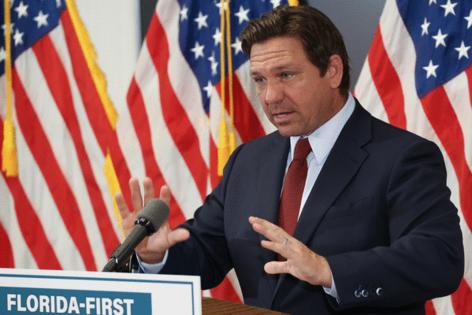As DeSantis calls for property tax cuts, 11 Central Florida governments propose hikes
Published in News & Features
While state leaders seek to stoke a tax revolt, at least 11 Central Florida cities and counties are signaling they may increase the rate they levy on property owners.
They cite a host of reasons, including the need to pay higher police and fire salaries, increased costs of insurance and construction materials, and the expense of unfunded mandates from state and federal governments.
Seminole County has been “conservative to our own demise” in recent decades, said commission chair Jay Zembower. Now, he said, infrastructure projects, the sheriff’s budget and other needs are finally catching up, propelling county commissioners to back a 10% rate increase last week.
“You can make an old truck last for 200,000 miles,” said Zembower, who owns an auto repair shop, at a recent meeting. “But when it gets to 400,000 miles, you don’t have a choice.”
But the moves come at a fraught time. Brushing aside his unsuccessful bid for a property tax rebate this year, Gov. Ron DeSantis is pressing forward on his idea of placing a referendum on the ballot to abolish property taxes in 2026. That tax revenue funds exclusively local needs, including public schools, police, fire and parks, and he hasn’t outlined how such services would be funded in a post-property tax world.
This week, DeSantis and new state CFO Blaise Ingoglia announced several on-site audits of local governments, which they said they believe will uncover wasteful spending and prove local budgets can be cut.
An Orlando Sentinel analysis in May found that local budgets have ballooned in Central Florida over the past five years, with counties benefiting from spiking property values. For example, Orange County’s budget grew by $1.7 billion since 2020 without raising its property tax rate.
“Quite frankly, local governments have been running amok for far too long,” Ingoglia said, noting that rising property values have pushed tax bills higher in recent years. “When your county comes out and says our millage rate is staying the same, that’s a tax increase in this scenario … Millage rate should be going down, not staying stable, and they definitely should not be going up.”
Aubrey Jewett, a political science professor at the University of Central Florida, said the local tax hikes show a disconnect between DeSantis’ goal of eliminating property taxes and local governments struggling to fund services as they grow more costly.
“I don’t know how much blowback there will be from the average resident … but I’m sure there’s going to be blowback from the governor and the CFO,” he said.
Across the region, most property owners should expect to pay more than last year even without a tax rate increase. Property values have ticked up across the region, meaning their bills will be higher even if rates remain flat.
Cities and counties have until early August to submit their maximum proposed rates to property appraisers. Rates can still be cut by elected officials when they approve budgets in September, but the proposed rates rarely change.
Of the 38 local governments examined by the Orlando Sentinel, elected officials in Seminole County, Astatula, Bay Lake, Belle Isle, Lake Buena Vista, Ocoee, Winter Garden, Casselberry, Oviedo, Mascotte, and Mount Dora proposed increases.
Only Clermont and Tavares are proposing decreases in their property tax rates, while 20 cities and counties are proposing flat tax rates — including Orange, Osceola and Lake counties. Six others didn’t have information publicly available and didn’t respond to attempts to reach them.
Seminole County is the largest local government proposing a tax increase, with commissioners this week signing off on a proposal of $5.38 per $1,000 of taxable value – or a bump of $0.50 per $1,000. It marks the conservative county’s first rate increase in 16 years. For a home with $300,000 taxable value, that would mean a $144 higher annual tax bill.
County leaders said this week they saw no other choice, in part because Seminole County Sheriff proposed a budget $16.2 million higher than the current year. Sheriff Dennis Lemma said the agency’s $58,024 starting salary, among the lowest in the area, is leading to young deputies leaving for higher pay elsewhere.
About a dozen county residents spoke out against the increase, contending county leaders could cut elsewhere to ease their burden and that individual taxpayers aren’t seeing benefits from their existing bills.
“Our tax liability is not providing an enhancement or an improvement in the county amenities,” said Linda Barker, of Sanford. “I’m not seeing value … we can’t even get a safe place on our road to walk.”
In Belle Isle, city staff are proposing a tax rate increase from $4.40 per $1,000 in taxable value to $5 per $1,000 in taxable value, contending the increase will just allow the city south of Orlando to maintain its existing level of services and cover price increases from Orange County for fire services. The city council is expected to take up the proposed increase July 29.
That same day, Casselberry’s city commission will consider proposing an increase from $2.90 per $1,000 in taxable value to $3.99 per $1,000 in taxable value, in part due to spiking police costs anda desire to sustain its reserves to respond to future natural disasters.
“Like every other municipality in the region, the City of Casselberry must develop a budget that is balanced and sustainable. The budget must enable the City to deliver all the services and local investment in infrastructure that our citizens demand,” City Manager Randy Newlon said in an email.
“The City has experienced extraordinary growth in labor costs, and particularly that of law enforcement,” Newlon said. “Other recurring revenues cannot support it. Budget planning must also consider the potential effects of an uncertain economy and changing State and Federal policies.”
Earlier this month, Ocoee argued that growth is no longer keeping up with inflation when it proposed increasing the rate to $5.50 per $1,000, up from $4.95.
“Failure to adopt this rate or pass the proposed increase to the fire protection assessment would directly jeopardize the City’s ability to sustain critical operations,” the agenda item from July 15 reads.
Oviedo cited a host of cost increases in bumping its rate to $5.96 per $1,000 – an increase of less than a penny, helping to pay for a 4% raise for employees, separate raises for police and fire, and 10% bump in insurance costs.
In Orlando, taxpayers will again pay $6.65 per $1,000 in taxable value for the 12th straight year, Mayor Buddy Dyer said.
The city’s $1.8 billion budget still faces strains from inflation, and salaries are going up as the unions representing much of the city’s workforce have new contracts this year. The budget calls for 20 new police officers, a new fire station and a temporary fire station on a swath of land annexed into the city last year.
“It’s a primary responsibility of city government: to do more with less,” Dyer said. “Our residents expect high-quality services, and that’s what we provide.”
_____
©2025 Orlando Sentinel. Visit orlandosentinel.com. Distributed by Tribune Content Agency, LLC.







Comments